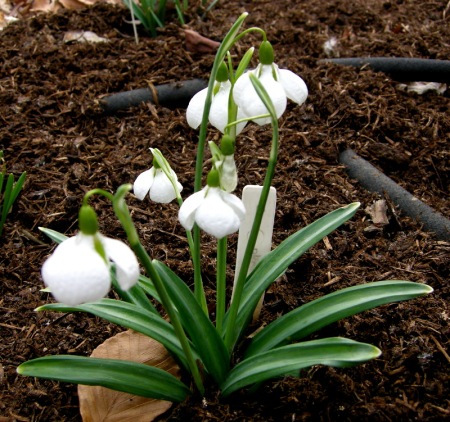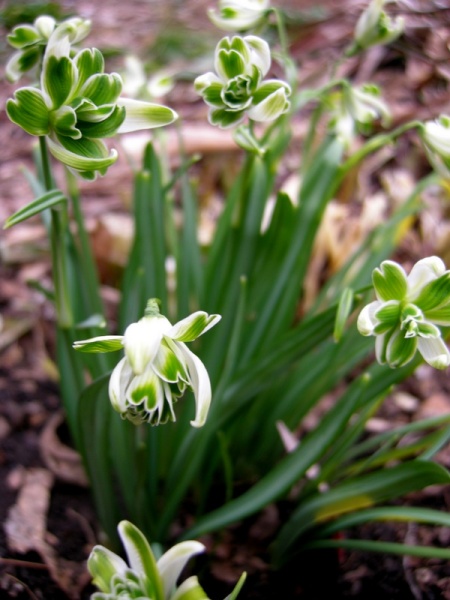‘Pieces of Eight’ is a new snowdrop found by renowned snowdrop hunter Veronica Cross.
Our 2020 Snowdrop Catalogue is on line here, and we are currently taking orders.
Michael and I just returned from two weeks in England visiting famous snowdrop venues and meeting the rock stars of the galanthus world. We found our way to Welford Park, Painswick Rococo Garden, Colesbourne Park, Avon Bulbs, East Lambrook Manor Garden (Margery Fish), Rodmarton Manor, the RHS Spring Show at Vincent Square, North Green Snowdrops, and Gelli Uchaf Garden in Wales.
And, even more fun, we spent time with Sir Henry and Lady Carolyn Elwes at Colesbourne, Alan Street at Avon and the RHS Show (plus Maxine and Mickey), Simon Biddulph at Rodmarton, Phil Cornish in his garden, John Morley at North Green, and Julian and Fiona Wormald in their Welsh garden. Thank you to all our wonderful hosts.
Nursery News: Carolyn’s Shade Gardens is a retail nursery located in Bryn Mawr, PA, specializing in showy, colorful, and unusual plants for shade. The only plants that we ship are snowdrops and miniature hostas. For catalogues and announcements of events, please send your full name, location, and phone number (for back up use only) to carolyn@carolynsshadegardens.com. Click here to get to the home page of our website for catalogues and information about our nursery and to subscribe to our blog.
.
 ‘Pieces of Eight’ combines a very bold form of the ‘Trym’/’Trumps’ type marking with the fuller, rounder look that I prefer in a snowdrop. I predict a big price on UK eBay if that hasn’t already happened.
‘Pieces of Eight’ combines a very bold form of the ‘Trym’/’Trumps’ type marking with the fuller, rounder look that I prefer in a snowdrop. I predict a big price on UK eBay if that hasn’t already happened.
1,500 photos later it is hard to know where to start especially since it is time for me to focus on shipping snowdrops. However, I thought it would be easy and fun to highlight some of the amazing snowdrops that are coming down the pipeline or have been very recently introduced. So here is a sneak preview of developments in the snowdrop world.
.
 Matt Bishop named this snowdrop ‘Neckless Wonder’ because it has no pedicel attaching it to the stem—not an endearing name but certainly descriptive. It is fun to be able to look straight into the flowers.
Matt Bishop named this snowdrop ‘Neckless Wonder’ because it has no pedicel attaching it to the stem—not an endearing name but certainly descriptive. It is fun to be able to look straight into the flowers.
.
 Although ‘Fiona’s Gold’, a G. nivalis cultivar, has been around for a few years, it really stood out for its bright yellow color. Most of the yellow snowdrops we saw looked anemic compared to what I am used to in the states because they need sun to turn gold, and there isn’t any over there. Michael and I expected terrible weather (and dressed for it), and we weren’t disappointed. It was freezing cold, damp, and raining or snowing most of the time we were there.
Although ‘Fiona’s Gold’, a G. nivalis cultivar, has been around for a few years, it really stood out for its bright yellow color. Most of the yellow snowdrops we saw looked anemic compared to what I am used to in the states because they need sun to turn gold, and there isn’t any over there. Michael and I expected terrible weather (and dressed for it), and we weren’t disappointed. It was freezing cold, damp, and raining or snowing most of the time we were there.
.
 This charming snowdrop called ‘Compu.Ted’ was in the Avon RHS display. I was so busy helping to set up the exhibit and taking photos that I didn’t have a chance to ask Alan Street about the name. Edit: According to Emma Thick, it is one of John Sales’s snowdrops named after his grandson who works with/likes computers. Thanks, Emma!
This charming snowdrop called ‘Compu.Ted’ was in the Avon RHS display. I was so busy helping to set up the exhibit and taking photos that I didn’t have a chance to ask Alan Street about the name. Edit: According to Emma Thick, it is one of John Sales’s snowdrops named after his grandson who works with/likes computers. Thanks, Emma!
.
 ‘Miss Prissy’ with her outward facing stance really stood out. I wonder if she is named after the spinster hen in Looney Tunes.
‘Miss Prissy’ with her outward facing stance really stood out. I wonder if she is named after the spinster hen in Looney Tunes.
.
 ‘Joy Cozens’ is not new but it was the first time I saw an orange tip in person—it really is orange!
‘Joy Cozens’ is not new but it was the first time I saw an orange tip in person—it really is orange!
.
 I was also thrilled to see this thriving clump of ‘Anglesey Orange Tip’. None of the flowers opened while I was there so I don’t know if they maintain their orange hue.
I was also thrilled to see this thriving clump of ‘Anglesey Orange Tip’. None of the flowers opened while I was there so I don’t know if they maintain their orange hue.
.
 I thought this un-named snowdrop at North Green was gorgeous.
I thought this un-named snowdrop at North Green was gorgeous.
.
 A lovely G. gracilis cultivar named ‘Andreas Fault’ by Matt Bishop. Is it named for the San Andreas Fault in California or did Andrea do something wrong? Edit: According to Janet Benjafield, it is named for Andy Byfield by Matt Bishop, a teasing name. Thanks, Janet.
A lovely G. gracilis cultivar named ‘Andreas Fault’ by Matt Bishop. Is it named for the San Andreas Fault in California or did Andrea do something wrong? Edit: According to Janet Benjafield, it is named for Andy Byfield by Matt Bishop, a teasing name. Thanks, Janet.
.
 Veronica Cross, sticking with the Treasure Island theme, calls this beauty ‘Long John Silver’. Edit: According to Janet Benjafield, Treasure Island refers to a patch in Veronica’s garden that yielded these new snowdrops.
Veronica Cross, sticking with the Treasure Island theme, calls this beauty ‘Long John Silver’. Edit: According to Janet Benjafield, Treasure Island refers to a patch in Veronica’s garden that yielded these new snowdrops.
.
 This is Veronica’s ‘Treasure Island’, a star money maker. Unfortunately, it’s closed like many of the snowdrops I saw and photographed. When it is cold, gray, and raining every day, you get desperate and take the photo anyway. I never realized how lucky we American galanthophiles are with all our sun.
This is Veronica’s ‘Treasure Island’, a star money maker. Unfortunately, it’s closed like many of the snowdrops I saw and photographed. When it is cold, gray, and raining every day, you get desperate and take the photo anyway. I never realized how lucky we American galanthophiles are with all our sun.
.
 Another gorgeous snowdrop—just look at those outers—from Alan Street and named inadvertently ‘Grave Concern’. Quite a somber name for such a beautiful flower, apparently it was found in a graveyard.
Another gorgeous snowdrop—just look at those outers—from Alan Street and named inadvertently ‘Grave Concern’. Quite a somber name for such a beautiful flower, apparently it was found in a graveyard.
.
 My only sighting of the record holder for most expensive snowdrop, ‘Golden Fleece’. A little out of focus as I was on the east coast of England with the wind howling in from the North Sea and snow was falling. I always wonder if the name is a play on words.
My only sighting of the record holder for most expensive snowdrop, ‘Golden Fleece’. A little out of focus as I was on the east coast of England with the wind howling in from the North Sea and snow was falling. I always wonder if the name is a play on words. ‘Golden Fleece’ is going to be given a run for its money by another yellow Trym-form about to hit the market, ‘Midas’. This is actually a ‘Midas’ seedling as the real thing wasn’t open yet.
‘Golden Fleece’ is going to be given a run for its money by another yellow Trym-form about to hit the market, ‘Midas’. This is actually a ‘Midas’ seedling as the real thing wasn’t open yet.Who knows when any of these gorgeous snowdrops will be available in the US, but at least we know what’s coming.
Carolyn
.
Nursery Happenings: You can sign up to receive catalogues and emails about nursery events by sending your full name and phone number to carolynsshadegardens@verizon.net. Subscribing to my blog does not sign you up to receive this information. Please indicate if you will be shopping at the nursery or are mail order only.
Carolyn’s Shade Gardens is a local retail nursery in Bryn Mawr, Pennsylvania, U.S., zone 6b/7a. The only plants that we mail order are snowdrops and miniature hostas and only within the US.
Facebook: Carolyn’s Shade Gardens has a Facebook Page where I post single photos, garden tips, and other information that doesn’t fit into a blog post. You can look at my Facebook page here or click the Like button on my right sidebar here.
Notes: Every word that appears in orange on my blog is a link that you can click for more information. If you want to return to my blog’s homepage to access the sidebar information (catalogues, previous articles, etc.) or to subscribe to my blog, just click here.










































































































